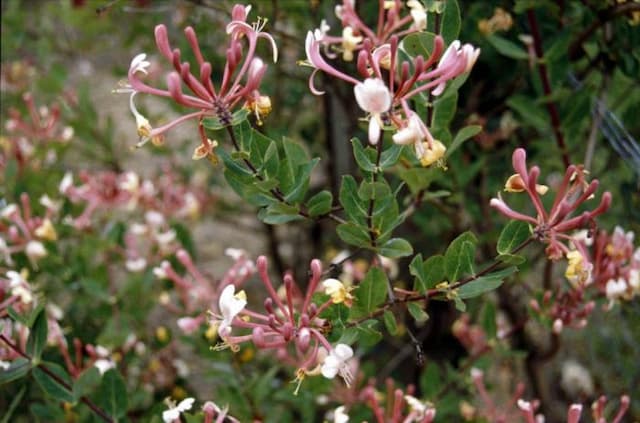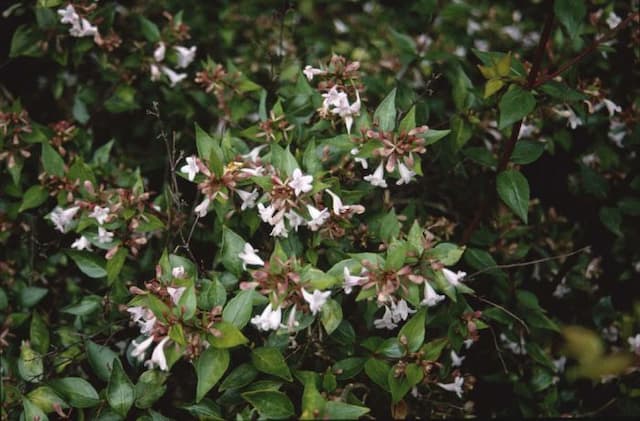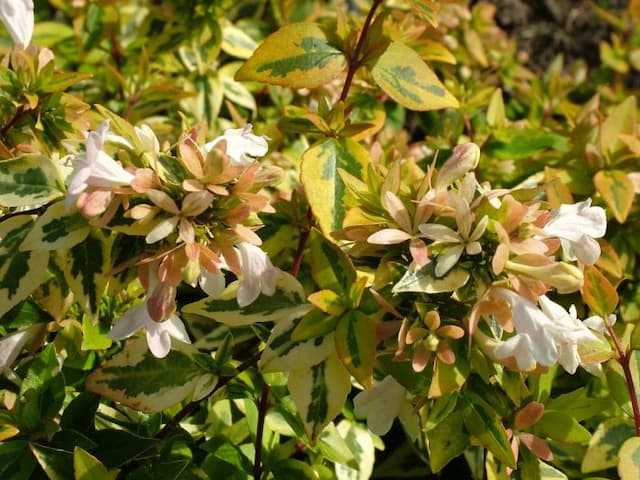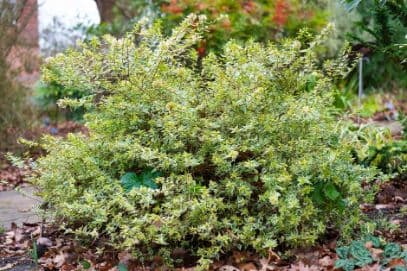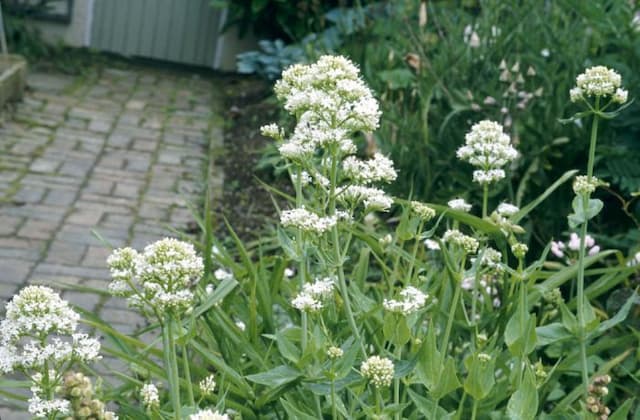Glossy Abelia Abelia × grandiflora 'Prostrate White'

ABOUT
Abelia × grandiflora 'Prostrate White' is a visually appealing plant that is known for its graceful and spreading form. This variety of abelia has a dense growth habit with arching branches that contribute to its elegant appearance. The leaves of this abelia are glossy and have a deep green hue, which creates a beautiful contrast with the white flowers. The plant blooms prolifically, producing an abundance of trumpet-shaped, white flowers that are attractive to pollinators like bees and butterflies. These flowers typically have a delicately fragrant scent that adds to the sensory experience of the plant. After the blooming period, the flowers may be followed by small, inconspicuous seed capsules. As the seasons change, the foliage may take on a purplish tinge, lending additional visual interest to the garden. The overall form of 'Prostrate White' is such that it contributes an aesthetic of softness and fullness to the landscape, making it a favored choice for gardeners seeking to add ornamental value.
About this plant
 Names
NamesFamily
Caprifoliaceae
Synonyms
Glossy Abelia, Abelia
Common names
Abelia × grandiflora 'Prostrate White'.
 Toxicity
ToxicityTo humans
The plant commonly known as Glossy Abelia is not known to be toxic to humans. There are no well-documented cases of poisoning or toxicity from ingesting any part of this plant. Therefore, no symptoms of poisoning are typically associated with Glossy Abelia.
To pets
Glossy Abelia is not known to be toxic to pets either. This includes common pets such as dogs and cats. There have been no significant reports of toxicity or poisoning in pets after ingesting this plant, and it is generally considered safe in the landscape where pets may have access to it.
 Characteristics
CharacteristicsLife cycle
Perennials
Foliage type
Semi-deciduous
Color of leaves
Green
Flower color
White
Height
2-3 feet (0.6-0.9 meters)
Spread
3-5 feet (0.9-1.5 meters)
Plant type
Shrub
Hardiness zones
6
Native area
Mexico
Benefits
 General Benefits
General Benefits- Attracts Pollinators: Abelia attracts bees, butterflies, and other beneficial insects, contributing to the health of your garden's ecosystem.
- Low Maintenance: This plant typically requires minimal pruning and care once established, making it ideal for low-maintenance landscapes.
- Drought Tolerance: Abelia is relatively drought-tolerant, making it a good choice for xeriscaping or areas with water restrictions.
- Year-Round Interest: With evergreen foliage and blooms that last from spring to fall, Abelia provides visual interest throughout the year.
- Compact Growth: Its prostrate growth habit makes it an excellent ground cover or border plant that fits well in small spaces or gardens.
- Deer Resistance: Abelia is not a preferred food source for deer, which can help prevent damage to the plant in areas where deer are common.
 Medical Properties
Medical PropertiesThis plant is not used for medical purposes.
 Air-purifying Qualities
Air-purifying QualitiesThis plant is not specifically known for air purifying qualities.
 Other Uses
Other Uses- Photography: Abelia can be used as a picturesque backdrop for outdoor portrait photography due to its lush greenery and white blossoms.
- Aromatherapy: The subtle fragrance of the Abelia flowers can be used to create a relaxing atmosphere in outdoor living spaces.
- Culinary Garnish: While not widely known for its edibility, the flowers can be used as delicate, ornamental garnishes for special dishes, after ensuring they haven't been treated with any chemicals.
- Artistic Inspiration: The structure and form of Abelia inspire artists for botanical drawings or as models for painting and sculpture studies.
- Erosion Control: Due to its spreading habit, Abelia can be planted on slopes to help prevent soil erosion.
- Privacy Screening: With strategic placement, dense Abelia shrubs can be used to create a natural privacy screen in gardens.
- Theme Gardens: Abelias can be used in moon gardens where white-flowering and silver-foliaged plants are showcased, more so because it blooms well into the evening.
- Education: Abelia serves as an ideal subject for horticultural lessons in pruning, as it responds well to trimming and shaping.
- Habitat Creation: Gardeners can use the plant to create habitats for beneficial insects, such as bees and butterflies, which are attracted to its flowers.
- Bonsai: Although not typical, Abelia can be trained into a bonsai form, offering a challenge to bonsai enthusiasts seeking to work with less common species.
Interesting Facts
 Feng Shui
Feng ShuiThe Glossy Abelia is not used in Feng Shui practice.
 Zodiac Sign Compitability
Zodiac Sign CompitabilityThe Glossy Abelia is not used in astrology practice.
 Plant Symbolism
Plant Symbolism- Perseverance: The Abelia × grandiflora 'Prostrate White' is known for its ability to adapt to different soils and conditions, symbolizing the capacity to endure and persist through challenges.
- Innocence: The white flowers of Abelia can represent purity and innocence, conveying a sense of simplicity and virtue.
- Beauty: With its attractive flowers and foliage, the plant symbolizes beauty, reminding one of the aesthetic pleasures of nature.
- Harmony: The shrub's growth pattern and the way its flowers harmonize with the environment embody balance and coexistence.
- Renewal: As Abelia plants can bloom for several months, they are often seen as symbols of renewal and rebirth, highlighting the cycle of life and new beginnings.
 Water
WaterGlossy Abelia prefers consistent moisture, but it is important not to overwater. Watering should be thorough, allowing water to penetrate deeply into the soil, which encourages deeper rooting. During the first growing season, water approximately twice a week, providing about 1-1.5 gallons each time, depending on the weather conditions to maintain evenly moist soil. Once established, watering frequency can be reduced, and the plant will require supplemental water only during prolonged dry spells, about once a week with the same amount. Always check the top few inches of soil for dryness before watering to prevent waterlogging.
 Light
LightGlossy Abelia thrives in a location that receives full sun to partial shade. The ideal spot for this plant would be one where it gets at least 6 hours of direct sunlight daily, though it can tolerate and bloom even in partial shade. Avoid deep shade locations, as this can reduce flowering and cause the plant to become leggy.
 Temperature
TemperatureGlossy Abelia is adaptable to a wide range of temperatures and can withstand minimum winter temperatures down to around 5°F, which is the general threshold for its cold hardiness. The ideal growing temperatures are between 65°F and 75°F. It can survive in summertime highs well above 75°F, provided it's watered adequately and not subjected to prolonged heat without relief.
 Pruning
PruningPruning Glossy Abelia is vital for maintaining its shape and encouraging the growth of new flowers. The best time to prune is late winter or early spring before the new growth starts. Lightly prune to shape the plant and remove any dead or crossing branches. Glossy Abelia blooms on new wood, so annual pruning can also help promote more prolific blooming during the growing season.
 Cleaning
CleaningAs needed
 Soil
SoilGlossy Abelia prefers well-drained soil rich in organic matter with a pH of 5.5-7.5. A mix of garden soil, peat moss, and perlite or sand is ideal to ensure good drainage and aeration.
 Repotting
RepottingGlossy Abelia is typically planted in the garden and does not require frequent repotting. If grown in containers, repotting every 2-3 years is sufficient to refresh the soil and provide space for growth.
 Humidity & Misting
Humidity & MistingGlossy Abelia is adaptable but prefers moderate humidity levels; it performs well in average outdoor humidity found in its growing regions.
 Suitable locations
Suitable locationsIndoor
Place Glossy Abelia by a south-facing window for light.
Outdoor
Plant Glossy Abelia in sun to part-shade and shelter.
Hardiness zone
6-9 USDA
 Life cycle
Life cycleAbelia × grandiflora 'Prostrate White', commonly known as Glossy Abelia, begins its life cycle when its seeds germinate in spring. The young seedlings develop into juvenile plants, characterized by rapid vegetative growth and the development of a root system and foliage. As the plants mature, they enter the flowering stage, usually in the summer, when they produce white, fragrant flowers that attract pollinators. After pollination, the flowers develop into small, inconspicuous seed capsules that eventually release seeds, thereby completing the reproductive cycle. Throughout its life, Glossy Abelia may undergo pruning and shaping, which encourages bushier growth and more prolific flowering in subsequent seasons. With proper care, this semi-evergreen shrub can live for many years, often requiring minimal maintenance once established.
 Propogation
PropogationPropogation time
Spring to Summer
The most popular method of propagating Abelia × grandiflora 'Prostrate White', commonly known as Glossy Abelia, is through softwood cuttings. Cuttings are best taken in late spring or early summer when new growth is still flexible but begins to harden. Select healthy, non-flowering stems and make a cut about 4 to 6 inches (10 to 15 centimeters) long just below a set of leaves. Remove the lower leaves, dip the cut end in rooting hormone, and then insert the cutting into a pot filled with a moistened mix of half peat and half perlite or sand. Cover the cutting with a plastic bag to retain humidity and place it in indirect light. After a few weeks, check for root development by gently tugging on the cutting. Once roots have established, the new Abelia plants can be transferred to individual pots and eventually into the garden.



